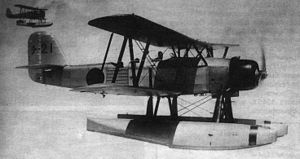Kawanishi E7K
| E7K | |
|---|---|
 |
|
| Role | reconnaissance floatplane |
| Manufacturer | Kawanishi Aircraft Company |
| First flight | 6 February 1933 |
| Introduction | 1935 |
| Retired | 1943 |
| Primary user | IJN Air Service |
| Number built | 533 |
The Kawanishi E7K was a Japanese 1930s three-seat reconnaissance floatplane. It was allocated the reporting name Alf by the Allies of World War II.
In 1932 the Imperial Japanese Navy requested the Kawanishi Aircraft Company to produce a replacement for the company's Kawanishi E5K. The resulting design, designated the Kawanishi E7K1, was an equal span biplane powered by a 462 kW (620 hp) Hiro Type 91 W-12 liquid-cooled inline engine. The first aircraft flew on 6 February 1933 and was handed over to the navy for trials three months later. It was flown in competition with the Aichi AB-6 which was designed to meet the same 7-Shi requirement. The E7K1 was ordered into production as the Navy Type 94 Reconnaissance Seaplane (九四式水上偵察機) and entered service in early 1935. It became a popular aircraft, but was hindered by the unreliability of the Hiro engine. Later production E7K1s were fitted with a more powerful version of the Hiro 91, but this did not improve the reliability. In 1938 Kawanishi developed an improved E7K2 with a Mitsubishi Zuisei 11 radial engine, it first flew in August 1938 and was ordered by the Navy as the Navy Type 94 Reconnaissance Seaplane Model 2. The earlier E7K1 was renamed to Navy Type 94 Reconnaissance Seaplane Model 1.
The type was used extensively by the Japanese Navy from 1938 until the beginning of the Pacific War, when E7K1 were relegated to second-line duties. The E7K2 continued in front-line service until 1943 and both versions were used in Kamikaze operations in the closing stages of the war.
Data from Japanese Aircraft of the Pacific War
General characteristics
Performance
Armament
...
Wikipedia
